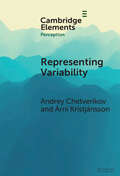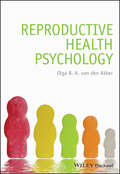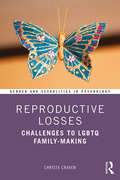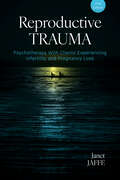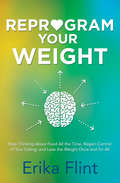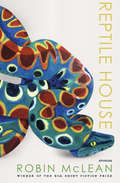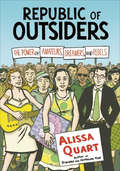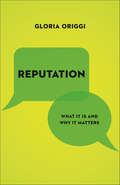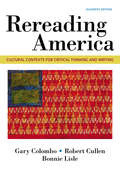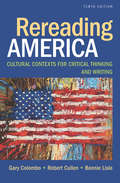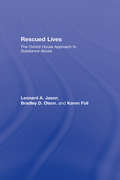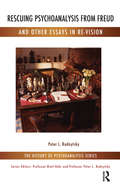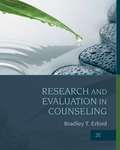- Table View
- List View
Representing Variability: How Do We Process the Heterogeneity in the Visual Environment? (Elements in Perception)
by Andrey Chetverikov Árni KristjánssonThe visual world is full of detail. This Element focuses on this variability in perception, asking how it affects performance in visual tasks and how the variability is represented by human observers. The authors highlight different methods for assessing representations of variability and suggest that understanding visual variability can be elusive when straightforward explicit methods are used, while more implicit methods may be better suited to uncovering such processing. The authors conclude that variability is represented in far more detail than previously thought and that this aspect of perception is vital for understanding the complexity of visual consciousness.
Reprising Craftsmanship: An Expressive Approach to Skill (SpringerBriefs in Psychology)
by Pablo RojasCraftsmanship provides an insight into an inherently human dimension of work resulting from our immersion in an occupation or profession. The present book illustrates and defines the vital, social, aesthetic, and ethical dimensions involved in craftsmanship, which rejects a dissociation between handwork and wit, or between action and thought. This also contrasts with the neglect contemporary psychology has shown toward craftsmanship and its reduction to mere ‘human factors.’ Drawing on artistry as an emblem, the present account conveys that skilful action can only be renewed in a cycle involving both the personal and the transgenerational. There is little doubt in psychological and anthropological literature that the current global crises cannot be separated from social predicaments; namely, from the commodification of craftsmanship. In this book, the development of skilful action attests to a fundamental involvement required to sustainably perpetuate human endeavours. The role of expressivity in reappropriating technical activity is key in showing the continuous revaluation of our ethics and aesthetics of work, practice, and creation. The overall arc of the volume shows a movement from responsivity to responsibility. In short, if we are to reformulate our relationship to work and craft, we need to see through our responsibility in technique. The particularities of craftsmanship described here aim to contribute to such reformulation.
Reproduction of Tactual Textures
by Michaël WiertlewskiTexture accounts for an important part of the realism of simulated experiences, and it is most certainly true during tactile interaction. We usually experience roughness by running our fingers onto the explored surface. The perception of this fine texture is mediated by the vibrations generated by the encounters of the skin and the asperities of the surfaces. Reproduction of Tactual Textures presents factors that contribute to the mechanics of the interaction between a bare finger and a surface with a view to their artificial reproduction. It discusses the recording and reproduction of tactual textures, and analyses a case study of the development of a device able to record the vibratory signal from a fingertip sliding over a textured surface. The same device is then used in a reverse way to render those previously measured signals to the user's fingertip. These developments open new questions about the biomechanical properties of the skin and their relation to perception. The second half of Reproduction of Tactual Textures focuses on the implication of the dynamic parameters of the skin onto rendering performance, and it concludes with a study on the important features that are present in the vibratory signal and their relation to texture perception. This state-of-the-art volume highlights the importance of the mechanics and biomechanics during the haptic exploration of surfaces and their possible contribution to perception. Collectively, the findings reported are pertinent to many applications, including robotic perception and the design of effective virtual reality systems.
Reproductive Health Psychology
by Olga B. van den AkkerThis volume provides a comprehensive, up-to-date theoretical and empirical background to the psychology of reproductive health. Provides a life span perspective of the psychology of reproductive health and its disorders, from menarche to menopause and reproductive health in older ageFocuses on issues of the individual's reproductive health experience, including reproduction, pregnancy, maternity, and birth, as well as conditions such as PMDD, dysmenorrhea, and events including pregnancy failure, and abortionAcknowledges the wider social context with discussions of poverty, inequality, educational and economic status, age, and urban versus rural accessAddresses life style related factors, human rights to choice, information and access, fertility control and reproductive health regulation and health care servicesIllustrates topics with empirical data supported with tables and figures
Reproductive Health and Cancer in Adolescents and Young Adults
by Gwendolyn P Quinn Susan T. VadaparampilReproductive medicine is a growing field with new technology emerging faster than we can assess consumer's perceptions of -the number of cancer survivors are growing and there is a great need to attend to their quality of life-this book addresses the needs of males and females, identifies effective communication strategies and proactive measures for health care professionals and researchers to use as well as identifying gaps in the literature where more research is needed.
Reproductive Health and Maternal Sacrifice
by Pam LoweThis book demonstrates that the symbol of maternal sacrifice is the notion that 'proper' women put the welfare of children, whether born, in utero or not conceived, over and above any choices and desires of their own. The idea of maternal sacrifice acts as powerful signifier in judging women's behaviour that goes beyond necessary care for any children. The book traces its presence in various aspects of reproductive health, from contraception to breastfeeding. Pam Lowe shows how although nominally choices are presented to women around reproductive health, maternal sacrifice is used to discipline women into conforming to specific norms, reasserting traditional forms of womanhood. This has significant implications for women's autonomy. Women can resist or reject this disciplinary position when making reproductive decisions, but in doing so, they may be positioned as transgressing and/or need to justify their decisions. The book will be of great interest to scholars of sociology, gender studies and health studies.
Reproductive Losses: Challenges to LGBTQ Family-Making (Gender and Sexualities in Psychology)
by Christa CravenAlthough there are far more opportunities for LGBTQ people to become parents than there were before the 1990s, attention to the reproductive challenges LGBTQ families face has not kept pace. Reproductive Losses considers LGBTQ people’s experiences with miscarriage, stillbirth, failed adoptions, infertility, and sterility. Drawing on Craven’s training as a feminist anthropologist and her experiences as a queer parent who has experienced loss, Reproductive Losses includes detailed stories drawn from over fifty interviews with LGBTQ people (including those who carried pregnancies, non-gestational and adoptive parents, and families from a broad range of racial/ethnic, socio-economic, and religious backgrounds) to consider how they experience loss, grief, and mourning. The book includes productive suggestions and personal narratives of resiliency, commemorative strategies, and communal support, while also acknowledging the adversity many LGBTQ people face as they attempt to form families and the heteronormativity of support resources for those who have experienced reproductive loss. This is essential reading for scholars and professionals interested in LGBTQ health and family, and for individuals in LGBTQ communities who have experienced loss and those who support them. See additional material on the companion website: www.lgbtqreproductiveloss.org/
Reproductive Trauma: Psychotherapy With Clients Experiencing Infertility and Pregnancy Loss
by Dr. Janet Jaffe PhDThis second edition gives mental health professionals the tools they need to treat patients who suffer from infertility or pregnancy loss, as well as new guidance for processing their own reproductive traumas. Prospective parents who experience infertility or pregnancy loss deal with a host of physical and psychological consequences. For many individuals and couples experiencing reproductive trauma, their ideal future has fallen apart, leaving them bereft and hopeless. Author Janet Jaffe demonstrates how helping professionals can work with patients&’ reproductive stories to help them grieve, cope, and heal while underscoring how clinicians&’ own reproductive stories impact their lives and their therapeutic work. With updates in research and new, more diverse case examples, this edition has been expanded to offer a more holistic understanding of reproductive trauma, including coverage of LGBTQ+ parents and their unique needs and experiences. It also reviews advances in reproductive technology and their ethical implications—including cryopreservation, third-party reproduction, and genetic testing—as well as how social and cultural factors influence parents&’ reproductive stories.
Reprogram Your Weight: Stop Thinking about Food All the Time, Regain Control of Your Eating, and Lose the Weight Once and for All
by Erika FlintHypnosis techniques to get you to a healthy weight once and for all. In Reprogram Your Weight, award-winning hypnotist Erika Flint combines insightful, leading-edge hypnosis techniques with client success stories of weight loss. She understands that many people don&’t know what to do to lose weight—and often have a hard time consistently following through. Some people feel like there&’s something deeper going on inside that&’s keeping them from achieving their weight loss goal. Here, Flint shows how to bring these issues to the surface and combat them in a healthy, mindful manner. Within these pages lies the roadmap to a healthier, happier you!
Reptile House
by Robin McLeanThe characters in these nine short stories abandon families, plot assassinations, nurse vendettas, tease, taunt, and terrorize. They retaliate for bad marriages, dream of weddings, and wait decades for lovers. How far will we go to escape to a better dream? What consequences must we face for hope and fantasy? Robin McLean's stories are strange, often disturbing and funny, and as full of foolishness and ugliness as they are of the wisdom and beauty all around us.Robin McLean holds an MFA from UMass Amherst. She teaches at Clark University and lives in Bristol, New Hampshire, and Sunderland, Massachusetts.
Republic of Lies: American Conspiracy Theorists and Their Surprising Rise to Power
by Anna Merlan“[An] engrossing assessment of the profitable mainstreaming of conspiracy mongering in civic and political life . . . A lucid look at a slippery topic.” —Kirkus ReviewsAmerican society has always been fertile ground for conspiracy theories, but with the election of Donald Trump, previously outlandish ideas suddenly attained legitimacy. Trump himself is a conspiracy enthusiast: From his claim that global warming is a Chinese hoax to the accusations of “fake news,” he has fanned the flames of suspicion.But it was not one man alone who gave these ideas increased power. Republic of Lies looks beyond the caricatures of conspiracy theorists to explain their tenacity. Without lending the theories validity, Anna Merlan gives a nuanced, sympathetic account of the people behind them, across the political spectrum, and the circumstances that helped them take hold. The lack of a social safety net, inadequate education, bitter culture wars, and years of economic insecurity have created large groups of people who feel forgotten by their government and even besieged by it. Our contemporary conditions are a perfect petri dish for conspiracy movements: a durable, permanent, elastic climate of alienation and resentment. All the while, an army of politicians and media figures have peddled fear to serve their own ends.Bringing together penetrating historical analysis and gripping on-the-ground reporting, Republic of Lies transforms our understanding of American paranoia.“A captivating book that illuminates the landscape of conspiracy theories and what they might say about society as a whole.” —New York Magazine
Republic of Outsiders: The Power of Amateurs, Dreamers, and Rebels
by Alissa Quart&“Vivid portraits&” of individuals and subcultures by a writer who &“unmasks the assumptions we make about what counts as normal&” (The New York Times). They are outsiders who seek to redefine fields from mental health to diplomacy to music. They push boundaries and transform ideas. They include filmmakers crowdsourcing their work, transgender and autistic activists, and Occupy Wall Street&’s &“alternative bankers.&” These people create and package themselves in a practice cultural critic Alissa Quart dubs &“identity innovation.&” In this &“fascinating&” book, Quart introduces us to individuals who have created new structures to keep themselves sane, fulfilled, and, on occasion, paid. This deeply reported book shows how these groups now gather, organize, and create new communities and economies. Without a middleman, freed of established media, and highly mobile, unusual ideas and cultures are able to spread more quickly and find audiences and allies. Republic of Outsiders is a critical examination of those for whom being rebellious, marginal, or amateur is a source of strength (Barbara Ehrenreich). &“Even if you don&’t consider yourself an outsider or a rebel, Quart&’s book has several lessons for creative work, particularly when it comes to making art outside a heavily commercial system.&” —Fast Company &“One of the smartest cultural interpreters of her generation. In Republic of Outsiders, she mixes sharp-eyed analysis with an empathetic heart. The result is a great read, and a brand-new lens through which to view outsiders, insiders—and ourselves.&” —Susan Cain, author of Quiet: The Power of Introverts in a World That Can&’t Stop Talking
Reputation: What It Is and Why It Matters
by Gloria OriggiA compelling exploration of how reputation affects every aspect of contemporary lifeReputation touches almost everything, guiding our behavior and choices in countless ways. But it is also shrouded in mystery. Why is it so powerful when the criteria by which people and things are defined as good or bad often appear to be arbitrary? Why do we care so much about how others see us that we may even do irrational and harmful things to try to influence their opinion? In this engaging book, Gloria Origgi draws on philosophy, social psychology, sociology, economics, literature, and history to offer an illuminating account of an important yet oddly neglected subject.Origgi examines the influence of the Internet and social media, as well as the countless ranking systems that characterize modern society and contribute to the creation of formal and informal reputations in our social relations, in business, in politics, in academia, and even in wine. She highlights the importance of reputation to the effective functioning of the economy and e-commerce. Origgi also discusses the existential significance of our obsession with reputation, concluding that an awareness of the relationship between our reputation and our actions empowers us to better understand who we are and why we do what we do.Compellingly written and filled with surprising insights, Reputation pins down an elusive subject that affects everyone.
Requiem for the Ego: Freud and the Origins of Postmodernism
by Alfred I. TauberRequiem for the Ego recounts Freud's last great attempt to 'save' the autonomy of the ego, which drew philosophical criticism from the most prominent philosophers of the period¿Adorno, Heidegger, and Wittgenstein. Despite their divergent orientations, each contested the ego's capacity to represent mental states through word and symbol to an agent surveying its own cognizance. By discarding the subject-object divide as a model of the mind, they dethroned Freud's depiction of the ego as a conceit of a misleading self-consciousness and a faulty metaphysics. Freud's inquisitors, while employing divergent arguments, found unacknowledged consensus in identifying the core philosophical challenges of defining agency and describing subjectivity. In Requiem, Tauber uniquely synthesizes these philosophical attacks against psychoanalysis and, more generally, provides a kaleidoscopic portrait of the major developments in mid-20th century philosophy that prepared the conceptual grounding for postmodernism.
Rereading America: Cultural Contexts For Critical Thinking And Writing
by Robert Cullen Gary Colombo Bonnie LisleRereading America remains the most widely adopted book of its kind because it works: instructors tell us time and again that they've watched their students grow as critical thinkers and writers as they grapple with cross-curricular readings that not only engage them, but also challenge them to reexamine deeply held cultural assumptions, such as viewing success solely as the result of hard work. Extensive apparatus offers students a proven framework for revisiting, revising, or defending those assumptions as students probe the myths underlying them. Rereading America has stayed at the forefront of American culture, contending with cultural myths as they persist, morph, and develop anew. The tenth edition, developed with extensive input from users, features a refreshed collection of readings with a new chapter that introduces students to one of the most pervasive myths of our time: technological innovation fosters a more equal society. Also in response to instructors' requests for more writing instruction, there are now more questions that help students apply to their own writing the strategies used in the readings.
Rereading America: Cultural Contexts For Critical Thinking And Writing
by Robert Cullen Gary Colombo Bonnie LisleRereading America remains the most widely adopted book of its kind because it works: instructors tell us time and again that they've watched their students grow as critical thinkers and writers as they grapple with cross-curricular readings that not only engage them, but also challenge them to reexamine deeply held cultural assumptions, such as viewing success solely as the result of hard work. <P><P>Extensive apparatus offers students a proven framework for revisiting, revising, or defending those assumptions as students probe the myths underlying them. Rereading America has stayed at the forefront of American culture, contending with cultural myths as they persist, morph, and develop anew.
Rereading America: Cultural Contexts for Critical Thinking and Writing
by Robert Cullen Gary Colombo Bonnie LisleRereading America remains the most widely adopted book of its kind because of its unique approach to the issue of cultural diversity. Unlike other multicultural composition readers that settle for representing the plurality of American voices and cultures, Rereading America encourages students to grapple with the real differences in perspectives that arise in our complex society. Selections model writing from a wide variety of disciplines and genres, and each chapter features a selection that explores how the media sells the myth in question. With extensive editorial apparatus that puts readings from the mainstream into conversation with readings from the margins, Rereading America provokes students to explore the foundations and contradictions of our dominant cultural myths.
Rereading America: Cultural Contexts for Critical Thinking and Writing
by Robert Cullen Gary Colombo Bonnie LisleRereading America remains the most widely adopted book of its kind because it works: instructors tell us time and again that they've watched their students grow as critical thinkers and writers as they grapple with cross-curricular readings that not only engage them, but also challenge them to reexamine deeply held cultural assumptions, such as viewing success solely as the result of hard work. Extensive apparatus offers students a proven framework for revisiting, revising, or defending those assumptions as students probe the myths underlying them. Rereading America has stayed at the forefront of American culture, contending with cultural myths as they persist, morph, and develop anew. The tenth edition, developed with extensive input from users, features a refreshed collection of readings with a new chapter that introduces students to one of the most pervasive myths of our time: technological innovation fosters a more equal society. Also in response to instructors' requests for more writing instruction, there are now more questions that help students apply to their own writing the strategies used in the readings.
Rereading America: Cultural Contexts for Critical Thinking and Writing (5th edition)
by Robert Cullen Gary Colombo Bonnie LisleRereading America presents diverse political and cultural perspectives as grist for critical thinking. Many of the book's 73 selections are from groups that have been pushed to the margins of our society -- people of color, women, gays and lesbians.
Rescue Warriors: The U. S. Coast Guard, America's Forgotten Heroes
by David HelvargHelvarg brings us into the daily lives of Coasties, filled with excitement, adrenaline, and dozens of death-defying rescues at sea and on land. Helvarg spent two years with the men and women of the Coast Guard, from the halls of the Coast Guard Academy in New London, Connecticut, to then frigid, storm-tossed waters of Alaska's Bering Sea, to the North Arabian Gulf, where they currently guard Iraqi oil terminals.
Rescued Lives: The Oxford House Approach to Substance Abuse
by Karen J. Foli Leonard A. Jason Bradley D. OlsonAn effective treatment to help those with addictions Victims of drug addiction, chronic illness, and mental illness all too often are overwhelmed with the affliction called hopelessness. Oxford Houses succeed because their substance abuse treatment approach instills the most powerful medicine—hope for recovery. Rescued Lives: The Oxford House Approach to Substance Abuse provides a comprehensive thought-provoking look at just how the innovative Oxford House model inspires positive action on one of our country’s most serious problems—substance abuse. This powerful book presents the success stories of the people living in these community homes and explains just how it has worked for them. Rescued Lives: The Oxford House Approach to Substance Abuse gives an insightful review of Oxford House’s history and the development of the approach. Residents’ stories reveal the treatment process on the road to recovery, allowing readers to glimpse the path each individual must travel to gain entrance and assimilate into the House community. As the residents gain more control over themselves living substance free, the reader discovers the importance of relationships and reframing of self in the recovery process. This powerful book can provide hope to those individuals who feel they have lost themselves in alcohol, drugs, and mental illness. Foreword by substance abuse scholar Bill White. Topics in Rescued Lives: The Oxford House Approach to Substance Abuse include: • an overview of substance abuse in today’s society • a history of Oxford House to the present • substance abuse treatment approaches • the process of a resident’s entrance and assimilation • providing hope and living substance free • the nationwide expansion of Oxford Houses • recovery, and what it means to women, children, and families • criminal offenders in Oxford House • how the Oxford House model is constructed in order to help disenfranchised individuals from society • the nine Oxford House Traditions • a review of the strong evidence that Oxford House works —and why • and more! Rescued Lives: The Oxford House Approach to Substance Abuse is enlightening reading for educators and students of psychology, sociology, urban studies, education, and other courses designed to prepare students for careers in the helping professions. This book is also essential for practicing clinicians, anyone concerned with society’s problems and those impacted by substance abuse and mental illness.
Rescuing Patty Hearst: Memories From a Decade Gone Mad
by Virginia HolmanIn 1975, one year after Patty Hearst and her captors robbed Hibernia National Bank, a second kidnapping took place far from the glare of the headlines. Virginia Holman's mother, in the thrall of psychosis, spirited her two daughters to a cottage on the Virginia Peninsula, painted the windows black, and set up the house as a MASH unit for a secret war. A war that never came. The family -- captive to her mother's schizophrenia and a legal system that refused to intervene -- remained there for more than three years. "What sets this book apart," theHartford Courantobserved, "is Virginia's voice. . . brave, smart, tough. " Reviewers nationwide have praised Holman's "riveting," "endearing," and "wryly humorous" story of a young girl caught in the whirlwind of madness -- a girl who chooses a brainwashed heiress as her role model. Holman's memoir vividly and brilliantly evokes the interior worlds of the sane and the insane and the delicate membrane in between. An essential exploration of identity, captivity, and love,Rescuing Patty Hearstwill inspire readers' faith in the resilience of one family's spirit to survive and thrive even in the direst of circumstances.
Rescuing Psychoanalysis from Freud and Other Essays in Re-Vision (The History of Psychoanalysis Series)
by Peter L. RudnytskyIn his latest groundbreaking book, the author examines the history of psychoanalysis from a resolutely independent perspective. At once spellbinding case histories and meticulously crafted gems of scholarship, Rudnytsky's essays are "re-visions" in that each sheds fresh light on its subject but they are also avowedly "revisionist" in their scepticism towards all forms of psychoanalytic orthodoxy. Beginning with a judicious reappraisal of Freud and ranging in scope from King Lear to contemporary neuroscience, the author treats in depth the lives and work of Ferenczi, Jung, Stekel, Winnicott, Coltart, and Little, each of whom sought to "rescue psychoanalysis" by summoning it to live up to its highest ideals.
Rescuing Sprite: A Dog Lover's Story of Joy and Anguish (Thorndike Basic Ser.)
by Mark R. LevinFrom the New York Times bestselling radio personality Mark Levin and his family comes the true story of the two years of joy and anguish they had with a rescue dog named Sprite.Mark Levin, while known as a lawyer and nationally syndicated broadcaster, considers himself first and foremost a dog lover. In 2004, Mark’s family added a new member to their bunch—a beautiful, Spaniel-mixed dog they named Sprite. With his beautiful face and soft, huggable fur, Sprite immediately bonded with the Levin family. But on Halloween night, just three weeks after being adopted, Sprite collapsed and had to be rushed to the animal hospital in what would turn out to be the first of many such visits—and a difficult, heart-wrenching journey for the entire family. Over the next two years, Sprite’s health deteriorated, but his spirit remained high and his beauty and grace continued to inspire, until the holiday season of 2006, when the Levin family had to say a final goodbye to their beloved pet. Rescuing Sprite is a stunningly intimate revelation of the strong love that can develop between a family and a pet, and the realization, as Mark Levin puts it, that “in the end, we humans are the lucky ones.”
Research And Evaluation In Counseling
by Bradley ErfordResearch is often an intimidating topic in a counselor training program. This text helps to alleviate students' concerns while helping them learn what they need to know. It presents the most essential components of research and illustrates them with meaningful examples, enabling students to master each component. Recognizing that the profession of counseling has entered the age of accountability, Erford developed RESEARCH AND EVALUATION IN COUNSELING to help educate counselors and future counselors about research and evaluation procedures so that their treatment of clients can be more effective and efficient. Organized into three topical sections, the second edition addresses the curricular requirements of the Council for Accreditation of Counseling and Related Educational Programs (CACREP), providing the latest information on research, statistics, and evaluation procedures.
